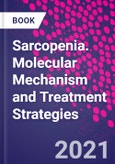Sarcopenia: Molecular Mechanism and Treatment Strategies provides answers and guidance on a disease that has serious health consequences in terms of fractures, frailty, disability and diminished quality of life. Written by experts around the world, this book is for all those that care for aging populations. As the global population ages, sarcopenia remains a therapeutic challenge and major public health concern. Difficulties in defining sarcopenia as a clinical phenotype remain and have hindered treatment.
Please Note: This is an On Demand product, delivery may take up to 11 working days after payment has been received.
Table of Contents
1. The definition of sarcopenia and the physical measures being associated with sarcopenia
2. Mitochondrial dysfunction linking to sarcopenia
3. The regulation of MicroRNA for sarcopenia
4. The relationship between neuromuscular junction and sarcopenia
5. The functional role of satellite cells in sarcopenic muscle
6. The molecular mechanisms of age-related anabolic resistance
7. The autophagic defect in sarcopenic muscle
8. Mitophagy system in sarcopenic muscle
9. Sarcopenia and the inflammatory cytokines
10. Skeletal muscle ECM remodeling and sarcopenia
11. Underlying mechanisms of sarcopenic obesity
12. Dysphagia in sarcopenia and cachexia
13. Under adjustment
14. Molecular mechanism of exercise for combating sarcopenia
15. Dietary approaches to maintain muscle mass
16. Pharmacological strategy for sarcopenia
17. Stem cells and sarcopenia with some translational aspect
18. Metabolic reprogramming attenuating sarcopenia








